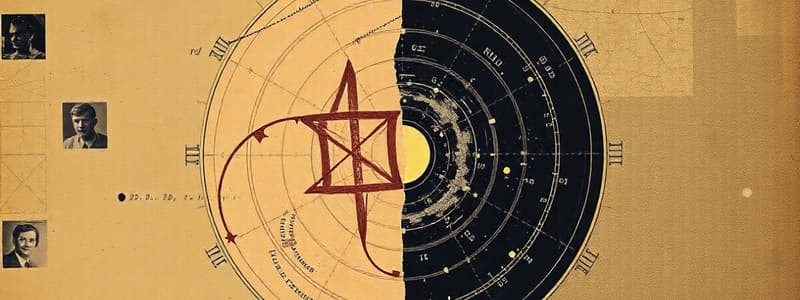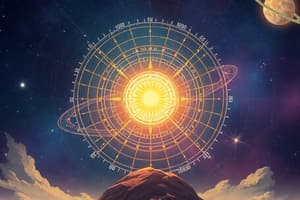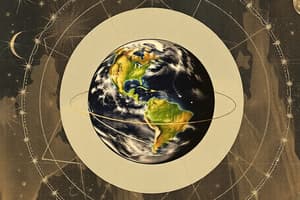Podcast
Questions and Answers
What is geocentrism?
What is geocentrism?
Geocentrism is a cosmological model where the Earth is placed at the center of the universe, and all other celestial bodies, including the Sun, orbit around it.
Who was Pythagoras?
Who was Pythagoras?
Pythagoras was a Greek philosopher and mathematician who laid the foundations of cosmological thought that would influence future astronomical considerations. He believed in a harmonious cosmos governed by mathematical laws.
Who was Philolaos?
Who was Philolaos?
Philolaos was a Pythagorean who was among the first to suggest that the Earth is in motion.
Who was Ptolemy?
Who was Ptolemy?
Who was Nicholas Copernicus?
Who was Nicholas Copernicus?
Who was Tycho Brahe?
Who was Tycho Brahe?
Who was Giordano Bruno?
Who was Giordano Bruno?
Who was Johannes Kepler?
Who was Johannes Kepler?
Who was Galileo?
Who was Galileo?
In 1616, the Catholic Church declared heliocentrism formally heretical.
In 1616, the Catholic Church declared heliocentrism formally heretical.
Flashcards
Geocentrism
Geocentrism
Cosmological model where Earth is at the center of the universe, with all celestial bodies, including the Sun, orbiting around it.
Heliocentrism
Heliocentrism
Cosmological model where the Sun is at the center of the solar system, with the Earth and other planets orbiting around it.
Pythagoras
Pythagoras
Greek philosopher who laid the foundations of cosmological thought that influenced future astronomical considerations and believed in a harmonious cosmos governed by mathematical laws.
Philolaos
Philolaos
Signup and view all the flashcards
Ptolemy
Ptolemy
Signup and view all the flashcards
Copernicus
Copernicus
Signup and view all the flashcards
Tycho Brahé
Tycho Brahé
Signup and view all the flashcards
Giordano Bruno
Giordano Bruno
Signup and view all the flashcards
Johannes Kepler
Johannes Kepler
Signup and view all the flashcards
Galileo Galilei
Galileo Galilei
Signup and view all the flashcards
Study Notes
- Geocentrism is a cosmological model where Earth is at the center of the universe, with all other celestial bodies, including the Sun, orbiting around it.
- Heliocentrism is a cosmological model where the Sun is at the center of the solar system, with Earth and other planets orbiting around it.
Early Theories and Discoveries
- Pythagoras (c. 570 - c. 495 BC): Greek philosopher and mathematician who laid the foundations of cosmological thought that influenced future astronomical considerations.
- Pythagoras believed in a harmonious cosmos governed by mathematical laws.
- Philolaus (c. 470 - c. 385 BC): A Pythagorean who was among the first to suggest that the Earth is in motion.
- Philolaus did not explicitly propose the heliocentric model as known today.
- Ptolemy (c. 100 - c. 168): Greek astronomer famous for his geocentric model, described in the Almagest.
- Ptolemy's geocentric model remained accepted for over a millennium.
- Ptolemy's model explained the movements of planets using concepts like epicycles and deferents.
The Copernican Revolution
- Nicolaus Copernicus (1473-1543) is the father of the heliocentric revolution.
- In his book "De revolutionibus orbium coelestium", published in 1543, Copernicus proposed that the Sun is at the center of the universe, with the Earth and other planets orbiting around it.
Developments and Controversies in the 16th Century
- Tycho Brahe (1546-1601): Danish astronomer who developed a hybrid geocentric model in which the Moon and the Sun revolved around the Earth, while the other planets revolved around the Sun.
- Despite resisting complete heliocentrism, Tycho Brahe's numerous precise observations of the planets played a crucial role for his successors.
- Giordano Bruno (1548-1600): Italian philosopher who supported and expanded Copernicus' heliocentric theory.
- Bruno proposed an infinite universe with other possible solar systems; his radical ideas led to his execution by the Church in 1600.
Consolidation of Heliocentric Theory in the 17th Century
- Johannes Kepler (1571-1630): German mathematician and astronomer who defined the laws of planetary motion that mathematically proved the heliocentric model.
- Kepler's three laws corrected and enriched Copernicus' theories.
- Galileo Galilei (1564-1642): Improved the telescope, allowing him to make observations supporting heliocentrism, such as the phases of Venus and the moons of Jupiter.
- These discoveries were decisive in reinforcing Copernicus' theory.
- The Catholic Church vigorously rejected heliocentrism, partly due to the literal interpretation of the Scriptures.
- In 1616, Copernicus' book was placed on the Index, and in 1633, Galileo was condemned for heresy.
Galileo and the Inquisition
- In 1616, the Roman Catholic Church formally declared heliocentrism heretical.
- Galileo was put on trial in 1633 for defending heliocentrism.
- Despite being forced to renounce his views, Galileo's work greatly contributed to modern science.
Studying That Suits You
Use AI to generate personalized quizzes and flashcards to suit your learning preferences.




